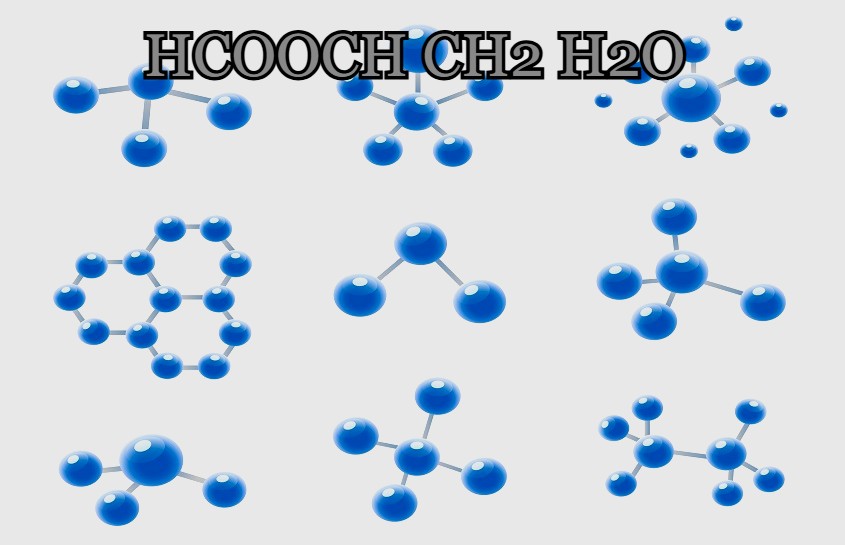The world of chemistry is built on the interactions of molecules, and one such interaction that stands out is the reaction involving HCOOCH CH2 H2O. This combination of methyl formate (HCOOCH₂), ethylene (CH₂), and water (H₂O) is not only a fascinating subject for chemical study but also a critical process with wide-ranging industrial applications. In this article, we discuss and deliver the science behind HCOOCH CH2 H2O, its reaction mechanisms, and its significance in fields such as energy storage, green chemistry, and industrial manufacturing.
Unveiling the Science: The Chemistry Behind HCOOCH CH2 H2O and Its Transformative Reactions
Chemistry is a field that thrives on understanding molecular interactions, and one fascinating reaction involves methyl formate (HCOOCH2), ethylene (CH2), and water (H2O). This process, primarily driven by hydrolysis, converts methyl formate into formic acid (HCOOH) and methanol (CH₃OH), two essential compounds widely used in industries. Ethylene, though not directly involved in the hydrolysis, can act as a catalyst or influence the reaction environment, enhancing efficiency.
This reaction is significant for chemical manufacturing, green energy, and industrial catalysis. Formic acid plays a crucial role in leather tanning and fabric processing, while methanol is a key ingredient in fuel production and plastic synthesis. Understanding this transformation not only deepens scientific knowledge but also paves the way for sustainable and efficient chemical processes.
The Reaction: HCOOCH CH2 H2O
The interaction of HCOOCH₂ CH₂ H₂O is a complex yet intriguing chemical process. Methyl formate, an ester with a fruity odor, reacts with water in the presence of ethylene to produce formic acid (HCOOH) and methanol (CH₃OH). The reaction can be summarized as follows:
HCOOCH₂ + H₂O → HCOOH + CH₃OH
While ethylene (CH₂) is not directly involved in the hydrolysis of methyl formate, it often plays a role in catalytic processes or as a precursor in related chemical reactions. The presence of ethylene can influence the reaction environment, making it more efficient or enabling the formation of additional byproducts.
Mechanism of the HCOOCH₂ CH₂ H₂O Reaction
The hydrolysis of methyl formate in the presence of ethylene follows a nucleophilic acyl substitution mechanism. Here’s a step-by-step breakdown of how “HCOOCH CH2 H2O” transforms into formic acid and methanol:
- Proton: In an acidic environment, the carbonilloxyxy of methyl format is protected, which increases the electrophilicity of carbonillarbon.
- Nucleophilic attack: A water molecule acts as a nucleophile, attacks electrophilic carbon and creates a tetrahedral intermediate product.
- Proton transfer: The attacker’s water molecule transfers a proton to the Methoxy Group (-OCH₃), stabilizing the intermediate product.
- Clevez: Intermediate collapses, C -o switch and release methanol (choh).
- DeProtonation: The remaining piece is removed for the dividend of formic acid (HCOOH).
Ethylene (CH₂) can act as a catalyst or participate in side reactions, depending on the reaction conditions. For example, ethylene may help stabilize intermediates or facilitate the formation of additional products, making the process more versatile.
Applications of the HCOOCH CH2 H2O Reaction

The reaction involving “HCOOCH CH2 H2O” has significant real-world applications across various industries:
- Chemical Manufacturing: The merchandise of this response—formic acid and methanol—are essential chemicals. Leather tanning, fabric processing, and preservation rely on formic acid, while methanol serves as a key feedstock for formaldehyde, plastics, and fuels.
- Green Chemistry: Methyl formate serves as an environmentally friendly solvent and refrigerant due to its low toxicity and biodegradability. Understanding the “HCOOCH CH2 H2O” reaction helps optimize processes that reduce environmental impact.
- Energy Storage: Researchers are exploring formic acid, a reaction product, as a hydrogen carrier for fuel cells. Its ability to release hydrogen upon decomposition makes it a promising candidate for clean energy solutions.
- Pharmaceuticals: This reaction produces intermediates and products essential for synthesizing pharmaceuticals, highlighting its importance in drug development and healthcare.
- Industrial Catalysis: The reaction is a model system for studying catalytic processes, which are crucial for developing efficient and sustainable chemical manufacturing methods.
Broader Implications: From Molecules to Mixtures
The “HCOOCH CH2 H2O” reaction is a microcosm of the broader principles of chemistry. It demonstrates how easily molecules can interact to form complicated combinations, every with precise homes and programs. This reaction also highlights the idea of chemical equilibrium, where the head (hydrolysis) and opposite (esterification) reactions reach a dynamic balance. Understanding this equilibrium is essential for optimizing business tactics and maximizing yields.
Moreover, the reaction underscores the significance of catalysis in chemistry. Acids, bases, or even ethylene can act as catalysts, rushing up the reaction without being fed on, that’s a cornerstone of inexperienced chemistry and sustainable business practices.
Environmental and Industrial Significance
The hydrolysis of methyl formate in the presence of ethylene is not just a chemical reaction; it is a gateway to sustainable innovation. As industries strive to reduce their environmental footprint, reactions like “HCOOCH CH2 H2O” offer pathways to greener alternatives. For example:
- Biodegradable Solvents: Methyl formate’s low toxicity and biodegradability make it an attractive alternative to traditional solvents.
- Renewable Energy: Formic acid’s potential as a hydrogen carrier aligns with global efforts to transition to renewable energy sources.
- Waste Reduction: Optimizing this reaction minimizes waste and maximizes resource efficiency, contributing to circular economy principles.
Conclusion
The reaction involving “HCOOCH CH2 H2O” is a testament to the power of chemistry to transform simple molecules into valuable products. From its role in chemical synthesis to its potential in renewable energy, this reaction exemplifies how fundamental science drives innovation and progress.
“HCOOCH CH2 H2O” By studying reactions, we now not only tricky on our information of chemistry, but also liberate new possibilities for sustainable development. In the lab, factory, or environment, this reaction shows how even the smallest molecules shape the future. As we reach the limits of these reactions, we create a cleaner, greener, and more innovative world.
